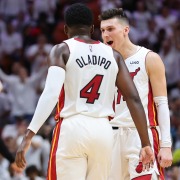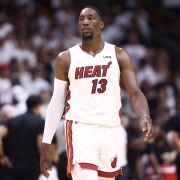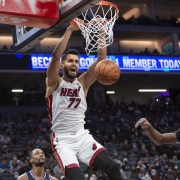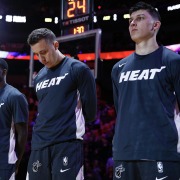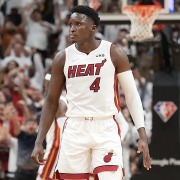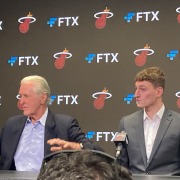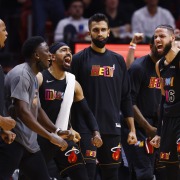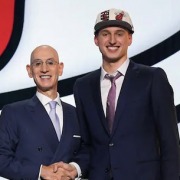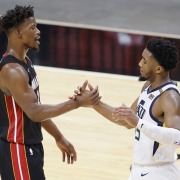The Ways to Maximize the Butler-Oladipo-Herro Pairing
When talking about the Heat potentially running it back to begin the season minus PJ Tucker, you could also make the case they’re running back the regular season by swapping Victor Oladipo for Tucker.
He was a guy that played a couple games late in the year, but was thrown in the mix during the playoffs to try and make it work on the fly.
But now that Miami re-signed him, this no longer consists of trial and error.
This is the real thing.
Yet when talking about him specifically, it’s more about how things will fit around him with certain lineup combinations. One of those awkward combos gained a ton of steam in their post-season run, but like I said earlier, they were basically trying things out to see how they’d look.
The combo that was gone to religiously was the Oladipo-Jimmy Butler-Tyler Herro grouping. They turned the keys over to a bunch of creators, basically knowing that the defending role players would hold up on the other end.
Looking at raw numbers within the advanced statistics, that three-man combo wasn’t the greatest. It logged a 107 offensive rating and 111 defensive rating over 97 minutes. But the issue with that is numbers like that don’t tell the full story.
Tyler Herro’s advanced stats were very poor late in their playoff run, bringing down a ton of lineup data. But something that always tells the truth: film.
I ended up rewatching all 97 minutes of the time they shared the floor, mainly focusing on the offensive end. And to scope even further, the half-court stuff. We know how and where all of them operate individually, but where do they blend all together?
There were some mixed variations, but I’m going to highlight the primary stuff that jumped off the screen. Starting somewhere that many of you can guess without even watching the film: spot-up shooting.
Just when using simple math, combining three on-ball creators means one has the ball in a pick and roll set, while the other two space out on each corner or wing. That, at times, became an unnecessary homebase for this Heat group, since there was zero consistency within that process.
Drive and kick, drive and kick, drive and kick. Yes, Tyler Herro and Victor Oladipo can knock down a spot-up corner triple, but it’s most definitely not the role you want them in.
Other than the fact that they’re better after putting the ball on the deck, the purpose of utilizing three creators is to ‘utilize them as three creators.’ The second they enter the three-point spacer role, the original purpose of this lineup has lost it’s value.
Now, this isn’t to say they won’t take advantage of the spot-up triple, but the process is the key element here.
With these three offensive builds, swing-swing-shot just won’t cut it.
Yet, swing-attack-paint touch-kick will cut it…
A common thread in their minutes together was that things always looked great when one of them got two feet in the painted area. When one of the three trusted mid-range threats build some momentum, the defense collapses slightly, which is basically the plot of how this can work.
Constantly move. I’ll get into that a bit more in a second, but when you look at some of the clips above, you’ll notice a difference in defensive disposition compared to normal spot-up shots.
They really found their groove in this department in the Philadelphia series. The Hawks series was a quick experiment late in the round, leading them into finding something offensively in the 76ers series, leading into facing a Boston defense who shut the water off around the rim if your name wasn’t Jimmy Butler.
But when talking regular season for the time being, that 76ers series is the blueprint.
We can talk about the starter competition all we want, but the truth is that doesn’t hold as much value as this does. Finding a way for this grouping to work changes everything. Lineup versatility, death lineup status, lengthier lineups on a team full of guards, etc.
But as we get into how they can make it work exactly, I must go back to the comment I made a second ago. When they share the floor, the key is to take the “motion offense” label and absolutely run with it.
Before I even say a word, watch the two clips above.
I can guarantee most of us are aligned on what we saw. Tyler Herro and Victor Oladipo impersonating statues.
Whenever it included Jimmy Butler isolations or pick and rolls, even considering how great he was at carrying this group, it was never a good sign for the offense in a specific run.
Herro is a rhythm player. Oladipo is a rhythm player. This type of standing around only leads to them being behind the 8-ball, and as I said earlier, you must bend the defense to be successful.
I hate comparing things like this to the Warriors, but they’re a great example. They have two of the greatest shooters ever to make it work, but the idea of constant movement to create opportunities off the dribble, not only from beyond the arc but at the rim, is how Miami can replicate things with this grouping.
When going back through this film, this created a ton of big time offensive runs in the playoffs, mostly at home. They started playing to the crowd, got out on the break, and were moving in the half-court.
But the next question becomes: how do they make this movement stuff work?
And well, this was my biggest takeaway after watching possession after possession of these three guys.
The answer isn’t even one of the three.
If we expand this into a 4 man lineup with Bam Adebayo, the offensive rating shot up to a 121 offensive rating over 53 minutes. Yet after watching the way they utilized Bam in these time slots, that number didn’t surprise me at all.
For starters, they played Bam much higher out in these lineups than they usually would. There are a couple reasons for that, but I’ll just give you two: 1) Taking that weak-side big away from the rim with 3 attackers on the floor is the way to go and 2) they basically said ‘hey Bam, play some quarterback for us.’
If you watch that 45 second video above, it’ll give you an idea of that in video form.
Miami completely played Bam above the break, and used guys like Herro and Oladipo as rim blitzers off the wing. It’s simply a way to beat the overplay, but it’s also a main priority of creating some offensive movement in the half-court while bending the defense.
Sometimes you’ll see a simple overhead pass over the top to an open cutter. Other times it’s a weak-side misdirection where two fly at Herro.
The point is that Bam Adebayo could be the clear connector to make this pairing work, specifically late in games. We’ve talked about letting Bam operate in more space. We’ve talked about giving him more of the offensive reigns.
This could end up being a way to blend all of that together.
Trust me: if I learned anything from those 97 minutes across 10 games of basketball, it was that they found certain pockets to make it work with Bam playing distributor. The next step will be combining all of these checkpoints into a strong offensive base.
The groundwork is there. Now it’s all about consistency.
I’m heavily focusing on select players in this piece, but that doesn’t mean I forgot about them working guys like Kyle Lowry, Gabe Vincent, or Caleb Martin into this mix.
This is a season where they’re going to use more three-guard lineups whether you like it or not, and Jimmy Butler at the 4 could most likely be the closing go-to, while I don’t believe it’ll be the starting choice.
Yet since Lowry was out for so many games over this stretch, I didn’t get a good enough idea of the specifics of that lineup. But another lineup addition jumped off the screen to bump this 4 man group into a full 5 man lineup.
Max Strus.
While it may seem odd, adding a shooter to this mix with constant screening, sprinting, and gravity shifted their half-court diet. Not only am I noticing this now, but the coaching staff clearly picked that apart with the amount of times they levitated toward that insertion when it truly mattered.
In 29 minutes, the lineup of Herro-Oladipo-Strus-Butler-Adebayo recorded a 132 offensive rating and 95 defensive rating. Yes, a VERY small sample size, but that wasn’t a coincidental occurrence. They found a blend to make things look clean, and if you look at the two clips above, you’ll notice the floor open up much wider when he’s moving around.
I know there are a lot of layers to this, but there will be a lot of layers to this season. And one of those layers is that if they run it back, making the Herro-Oladipo-Butler operate at a high level will be key.
You won’t get 2022 playoff Butler in this upcoming regular season. So now it’s time to equally split up the load. Or better yet, a Herro emergence or Oladipo comeback dominance may push this in the right direction even quicker.
Either way, it’s going to be unleashed.
For business window graphics, interior office signage, custom flags, custom banners and sign repair, reach out to SignsBrowardFortLauderdale
